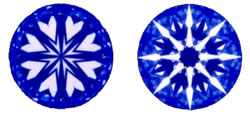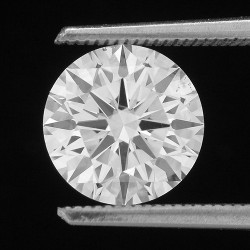 Diamond research in Japan during the 1970’s resulted in the development of a tool named the Firescope that provided visual image of the optical symmetry of a round brilliant diamond. The pattern is a series of eight gray arrowheads when the diamond is viewed from the top and a pattern of eight heart shapes when viewed from the bottom of the diamond. This pattern is called Hearts & Arrows (H&A).
Diamond research in Japan during the 1970’s resulted in the development of a tool named the Firescope that provided visual image of the optical symmetry of a round brilliant diamond. The pattern is a series of eight gray arrowheads when the diamond is viewed from the top and a pattern of eight heart shapes when viewed from the bottom of the diamond. This pattern is called Hearts & Arrows (H&A).
Hearts and Arrows Scope
 Subsequent Hearts & Arrows viewers were developed to display this pattern produced by optical symmetry. Keep in mind that optical symmetry is not the same as the Symmetry Grade seen on laboratory grading reports. Symmetry grading assesses the “neatness” of facet intersections and external placement. The optical symmetry examined with a Hearts & Arrows viewer is produced by the internal movement of light through the diamond and how it is reflected by the size, shape and placement of facets.
Subsequent Hearts & Arrows viewers were developed to display this pattern produced by optical symmetry. Keep in mind that optical symmetry is not the same as the Symmetry Grade seen on laboratory grading reports. Symmetry grading assesses the “neatness” of facet intersections and external placement. The optical symmetry examined with a Hearts & Arrows viewer is produced by the internal movement of light through the diamond and how it is reflected by the size, shape and placement of facets.
There is no link between optical symmetry and ideal proportions. A diamond can have great H&A pattern (optical symmetry) but not have ideal cut proportions. On the other had, a diamond can have ideal cut proportions and not display the H&A pattern. An H&A viewer does not accurately show light return or leakage and an Ideal-Scope does not accurately display the Hearts and Arrows pattern. The Ideal-Scope is a tool for evaluating cut proportions and the H&A viewer is a tool for evaluating optical symmetry.
There is also no direct tie between Symmetry Grade and Optical Symmetry. A diamond can be graded Excellent for symmetry by the GIA or Ideal for symmetry by the AGS and not display the H&A pattern. On the other hand, a diamond can display a beauty H&A pattern but not be in the highest symmetry grade.
Impact of Hearts & Arrows
Not all cutters spend the time to finish the surface with the greatest precision possible. Symmetry grade is based on the “neatness” in the shape and placement of facets that yield exact mirror images of opposite features. Specific facets must be aligned 180 degrees opposite of each other or the hearts and arrows pattern will be incomplete, misaligned, faded or distorted in appearance. If the cut of the diamond is even slightly less than symmetrical, the optical pattern will be uneven or incomplete.
 While it takes approximately one hour to cut the average round brilliant cut diamond, it can take up to four days to cut an ideal cut stone and even longer to finish a hearts and arrows stone because of the precision needed in the symmetry. On average, cutting a hearts and arrows ideal cut stone will require 15% greater waste of the original rough diamond. The greater time in cutting, increased diamond waste, and the high demand for hearts and arrows diamonds results in a premium price. Less than 1% of all diamonds are ideal cut and less than 0.1% display hearts and arrows.
While it takes approximately one hour to cut the average round brilliant cut diamond, it can take up to four days to cut an ideal cut stone and even longer to finish a hearts and arrows stone because of the precision needed in the symmetry. On average, cutting a hearts and arrows ideal cut stone will require 15% greater waste of the original rough diamond. The greater time in cutting, increased diamond waste, and the high demand for hearts and arrows diamonds results in a premium price. Less than 1% of all diamonds are ideal cut and less than 0.1% display hearts and arrows.
The GIA and AGS grading laboratories do not grade Hearts & Arrows pattern. As result, the determination of whether a diamond displays an H&A pattern is left to anyone examining the diamond with an H&A viewer. We have seen diamonds laser inscribed H&A or with an H&A brand that are not as sharp and crisp of patterns as one would expect from this type of marketing.
 One of the reasons the GIA and AGS have not incorporated an optical symmetry (H&A) grade in their cut grade systems is that their research has not shown that consumers preferred H&A diamonds to other ideal cut diamonds without the pattern. We personally find that round brilliant diamonds with the sharp and distinct pattern under the Hearts and Arrows scope will consistently display exceptional fire, scintillation and brightness to the eye, but that is our opinion and not necessarily one shared by all diamond shoppers.
One of the reasons the GIA and AGS have not incorporated an optical symmetry (H&A) grade in their cut grade systems is that their research has not shown that consumers preferred H&A diamonds to other ideal cut diamonds without the pattern. We personally find that round brilliant diamonds with the sharp and distinct pattern under the Hearts and Arrows scope will consistently display exceptional fire, scintillation and brightness to the eye, but that is our opinion and not necessarily one shared by all diamond shoppers.
While there is not definitive proof that a diamond displaying an H&A pattern are more beautiful, there is definite proof that the H&A pattern can contribute to a successful marketing strategy. There are numerous brands established based on the Hearts and Arrows pattern with the “Hearts on Fire” brand being one of the most successful brands in the diamond and jewelry industry.
The romantic connection between the Hearts in an H&A diamond and the gift of affection make a potent marketing point even though the Hearts (viewed from the bottom of the diamond) are not visible to the wearer once the diamond is set in a piece of jewelry.
Advice: If you want all the “bells and whistles” with your diamond, then getting and ideal cut diamond with a Hearts & Arrows pattern will probably produce long-term satisfaction with your diamond. On the other hand, since the H&A pattern is not particularly visible to the unaided eye, passing up a great value in an ideal cut diamond just because the H&A pattern is not precise or evident might be a poor shopping decision. Diamond shoppers need to determine their priorities for diamond characteristics including H&A and then find the diamond that optimizes those priorities.
